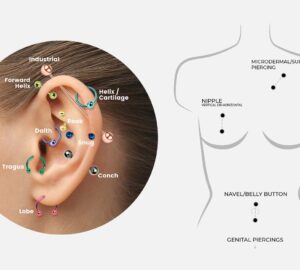look. There are two types of piercings that you can opt for – surface and dermal piercings.
Both, dermal and surface piercings can be done on any part of your body, such as your chest, lower back, the nape of the neck, hips and even above your cheekbone. Since both these piercings don’t penetrate Piercings are one of the most popular types of body modification that give you a beautiful and unique through the body, they can be placed anywhere. The only reservation for these piercings is that there should be enough skin of moderate thickness.
While both surface and dermal piercings have certain similarities and offer you the opportunity to express yourself creatively, they differ in more than one ways.
Let’s take a more detailed look at both these types of piercings.
Dermal Piercing
A dermal piercing makes a single point perforation in the sub-dermal skin layer of your body, which sets it apart from a surface piercing. This type of piercing is done by a professional piercer using either a dermal punch or a needle. However, most piercers tend to use the needle method for the perforation.
So, a small hole is created in your skin using a needle, followed by the insertion of a dermal anchor, which is around 6 to 7 millimeters long. The length of the anchor makes it ideal to help secure the piercing and hold it in place.
A dermal anchor comprises of holes in its base area that allows your skin tissue to heal around it. This further helps in security and stabilizing your piercing jewelry. One the piercing has been done, only the top decorative part of it is evident, which can be changed as often as you want.
One of the most integral things to know about dermal piercings is that once your piercing heals and you want to get rid of the piece under your skin, you will have to visit a professional piercer. If you attempt to remove a dermal piercing on your own, you will experience a lot of pain and discomfort.
Surface Piercing
A surface piercing is done using a hollow needle. This type of piercing is anchored using a barbell and is more invasive and deeper than a dermal piercing. While a dermal piercing has a single point of entry, a surface piercing requires a barbell to be guided under your skin for a specific distance.
Once this piercing has been positioned properly, you can add decorative jewelry to brighten it up. Moreover, surface piercings tend to leave more prominent scars in case of piercing migration or rejection.
Wrapping Up
Both surface and dermal piercings are good options for you. However, one thing you need to pay special attention to is the piercing aftercare. Only if you care for them properly will they heal quickly and efficiently otherwise, you can suffer from various skin problems such as infections.




